This is a Certo Doppel Box made by Certo Camera Werk of Dresden Germany around 1935. Some sources online suggest this camera was made in 1932, but I believe the later date to be correct. The Doppel Box is an all metal box camera with several unique features, the most notable is that it can be changed from shooting 6×9 images to 6×4.5 via a knob on the side of the camera that moves a hinged mask within the film compartment. The camera has a doublet lens and has a built in closeup lens allowing for images between 2 and 5 meters to be shot. Although the shutter is single speed, it supports both a Bulb and a Timed mode, and is threaded for a cable release. The Doppel Box was one of the better equipped box cameras ever made.
Film Type: 120 Roll Film (eight 6cm x 9cm or sixteen 6cm x 4.5cm exposures per roll)
Lens: 10.5cm f/11 Certomat uncoated 2-elements
Focus: Dual Range, 2 meter to 5 meter or 5 meter to Infinity
Viewfinder: Twin Brilliant, one each for Landscape or Portrait orientation
Shutter: Spring Tensioned Metal Blade
Speeds: T, B, M (~1/30 second)
Exposure Meter: None
Battery: None
Flash Mount: None
Manual: None
History
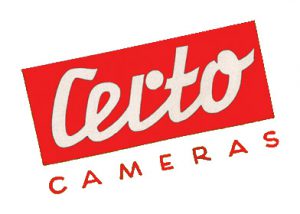 Certo Camera Werke was founded in 1902 by Alfred Lippert and Karl Peppel who were both German engineers. They adopted the name Certo which is Latin for “safe and reliable”, and released their first camera in 1905.
Certo Camera Werke was founded in 1902 by Alfred Lippert and Karl Peppel who were both German engineers. They adopted the name Certo which is Latin for “safe and reliable”, and released their first camera in 1905.
Throughout the early part of the 20th century, Certo released a variety of mid-priced folding cameras. Certo cameras were neither cheap nor top of the line, but they were respected in their day. Their products were comparable to Welta and Balda who were two other German camera manufacturers of the time. The company experienced it’s best success in the late 1920s and 30s before World War II.
Normally, I would continue to dive into the complex history of the Certo camera company where I’d tell you things like the names of their earliest models, or any innovations they had. I’d probably say something like “…during the war, Certo transitioned to making products for the German war effort…” Then after the war, you’d probably read “…Certo would resume producing their pre-war models with some new updates and eventually release…”
But for this review, I have something special. When collecting old cameras, you rarely get to hear any of the stories about their previous owner. Sometimes you’ll get the “I found this in my grandfather’s closet and I know he liked it…” but usually these stories are just foggy memories of some relative owning an old camera. These stories are great and all, because they show a sentimental value attached to a camera, but rarely do you hear anything truly interesting.
With this Certo Doppel Box, I was offered this camera in a local discussion group and the lady selling it said it was her father’s. I sent her an email asking if she had any more info about the camera, and this was her reply:
Hi Mike,
I am delighted to tell you what I know about this camera. My father (Istvan Laszlo Magyar) was born in 1917 in Budapest Hungary and fled to Switzerland shortly before WWII ended (May of 1945.)
He bought the camera in Switzerland (either in Winterthur or Zurich) sometime between 1945 and 1946. It was the first camera he ever owned. He used it and took many pictures with it until he was able to afford to buy a Leica. He married a Swiss girl, they had a son and then they immigrated to Australia where I was born. We then immigrated to America (in 1957) and they had one more child. He lived in America until his death in 2005.
He always took good care of whatever he owned…he had few possessions until he came to America. He became successful as and architectural and plumbing engineer. After his death, my mother and I were going through his things and she asked me if I wanted the box camera. And now you know the story! Hope you enjoyed it. I attached a photo of my father for your interest.
Regards,
Cece
Cece attached a cell phone image she took of a framed print of her father, and after a little bit of cropping, perspective correction, contrast adjustment, and some content aware healing in Photoshop, I came up with this.
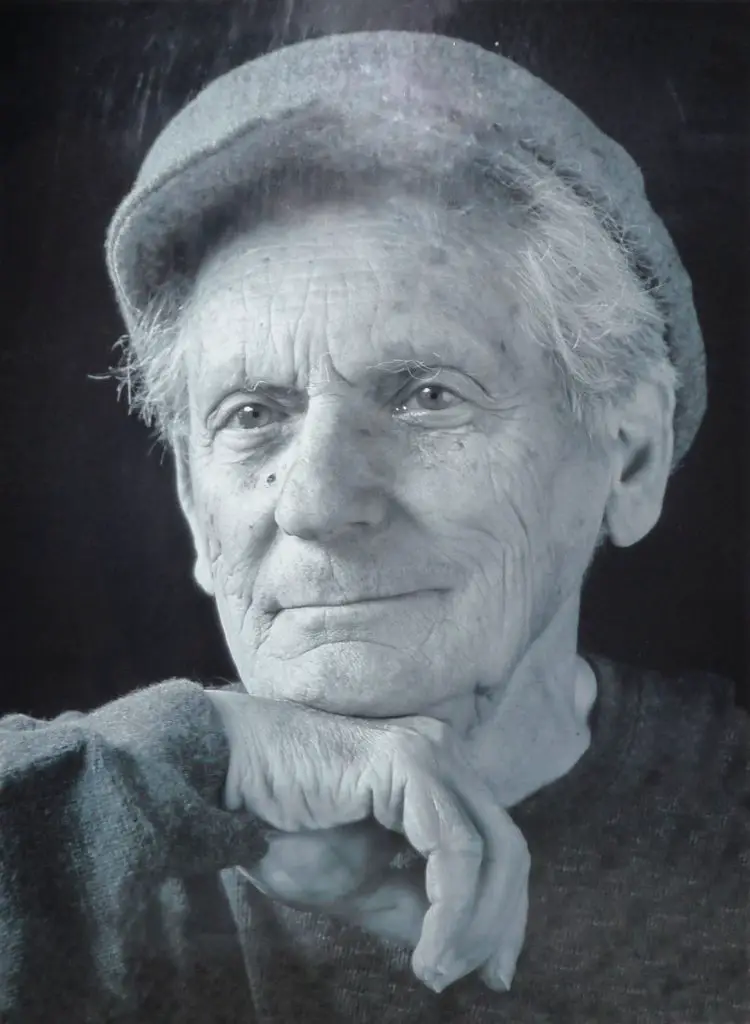
It’s one thing to hear about how someone’s father had used the camera to take vacation pictures at Niagara Falls or Yosemite National Park, but this camera was bought by a Hungarian immigrant in Switzerland after fleeing the Germans during World War II. Then got married, had a son, and then moved all the way to Australia, all before winding up here in the United States! What a story!
The camera was in excellent condition when I received it, and after reading Cece’s email about how her father took care of his stuff, really made me appreciate the journey this metal cube has had. Mr. Magyar might not be a celebrity, and it’s unlikely anyone reading this would likely ever have heard of him, but the fact that his prized possession that he took excellent care of for over 70 years eventually made it’s way to me, and now I get to tell it’s story, is awesome!
I apologize for not telling you more about Certo and all of it’s models. If you want to learn more, I have some additional info about the company and what happened to it in my reviews for the Certo Dollina II, and the Certo Super Sport Dolly.
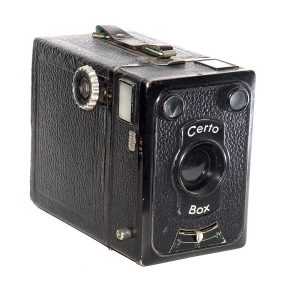
Regarding the Doppel Box itself, there appear to be a few variants of this camera. There was a regular Certo Box that lacked the dual format capability but otherwise is the same camera.
There were also two different lenses available in the Certo Boxes, a Ceronar, and a Certomat. According to the Historic Camera Librarium, the Model A came with the less expensive Ceronar lens, and the Model B came with the Certomat. I do not know what the differences were between the two lenses. Model A and Model B cameras appear to be available as Doppel and non-Doppel Boxes. The model being reviewed here has the Certomat lens, so I guess it’s a Model B.
I found no other information about production numbers or cost for the Doppel Box. On one hand, this seems to be a premium box camera, so prices might have been a bit higher than other entry level cameras of the day, but then again, Certo wasn’t a premium brand either, so maybe they were able to offer well featured cameras like this for competitively low prices.
Today, neither Certo Doppel Boxes or any Certo for that matter are in high demand by collectors. I don’t hear people talk about them much in collector groups, and certainly the Doppel Box itself is rarely on anyone’s radar. That’s a shame though, as Certo was one of those German companies that made some really nice and innovative models prior to the war. Although the company would still exist until at least the 1960s, their period of quality cameras ended with the war.
My Thoughts
I have always liked box cameras. I’ve found that when writing these reviews, the more basic the camera, the more impressed I am when I get anything resembling a good image. Images shot through a cardboard Kodak Brownie that look decent are more impressive to me than a razor shot image from a Nikon SLR, as I expect perfection from a modern precision instrument like an SLR.
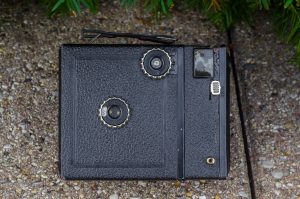
When I came across this Certo Doppel Box, I was impressed with it’s looks. The camera has that nickel and leather look that many pre-war German cameras have. All of the tactile parts like the knobs and sliders are elegantly designed. The patina of the brass really gives this camera a wow factor that you don’t often see on most cardboard or wooden box cameras.
The Doppel Box isn’t just a pretty camera though, it’s feature set is just as impressive. For starters, the body is entirely metal. There is nary a piece of cardboard, paper, or wood anywhere in the whole camera. The all metal body gives the Doppel Box some heft which inspires confidence.
Second, I was impressed with the ability to select between 3 aperture sizes, and fire the shutter in both Instant, Bulb, and Timed mode. Even the shutter release is threaded for a shutter release cable, making Timed shots all the more practical. The camera is even capable of “close focus” via an internally activated lens that swings in front of the taking lens for closeups that are between 2 and 5 meters away.
But it wasn’t until I saw the feature that gives the Doppel Box it’s “Doppel” (meaning double) name, which is it’s dual format capability. Normally, the Doppel Box shoots eight 6cm x 9cm images on a roll of 120 roll film, but by rotating a dial on the side of the camera, you can move a baffle that masks the film plane for sixteen 6cm x 4.5cm “half frame” images. I do not have a complete knowledge of every box camera ever made, but 6×4.5 box cameras are not common, making the Doppel Box quite special.
Loading film into the Doppel Box is mostly like other box cameras in that there is an inner film compartment that comes out of the main body of the camera. There is no “latch” or opening mechanism for the Doppel Box. The entire front of the camera folds down by gently pulling the top of the front forward and swinging the entire front down, exposing the inner film compartment. In order to pull the film compartment out of the camera, you must make sure the camera is set to 6×9 mode. You cannot remove this with the camera in 6×4.5 mode. If you have difficulty pulling the film compartment from the camera, this is the first thing I would check.
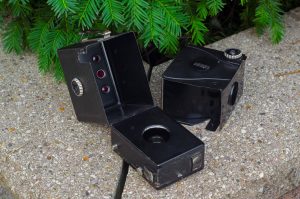
Once the film compartment is out of the camera, you’ll see two mounting points for spools, one on top and one on the bottom. The bottom position is where you load a fresh roll of film. Simply pry back the metal arm to give yourself room to load in a fresh roll of film and it should slide in. The takeup spool is on top, next to the winding knob. Once again, gently pry back the metal arm opposite the winding knob, and make sure the notch lines up with the key on the knob and your takeup spool should snap into place. Thread the paper leader from the supply spool, across the film plane all the way to the takeup spool on top of the camera and give it a few turns to make sure it is secured to the spool and insert the film compartment back into the camera. If you struggle getting the film compartment to go back into the camera, make sure that the baffle is still in 6×9 mode and the knob on the side of the camera is still set to 6×9 as it will not insert in any other position.
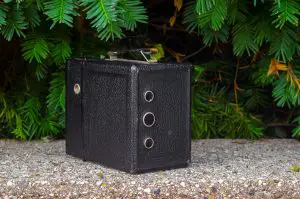
The back of the camera has three red windows, two smaller ones near the edges and a larger one in the middle. The smaller two holes are used for 6×4.5 images, and the larger center hole is for 6×9 images. You can switch between formats mid roll, but it requires additional effort to make sure you advance the film correctly so as not to overlap your images. I was able to do it, but it’s not easy, so I don’t recommend it for your first roll. You should decide whether you want to shoot 6×9 or 6×4.5 images for your entire roll.
If you intend on 6×9 images, you need to advance the film until the number 1 appears in the large window and just keep winding the film so each number up to 8 is in that same window. If you intend on 6×4.5 images, you need to advance the film until the number 1 appears in the bottom small window. After taking your first photo, advance the film until the number 1 is in the small upper window and take your second photo. The third photo will be taken with the number 2 in the bottom window, and so on. You’ll keep doing this where you use the same number once in each window until your 16th image, which is done with the number 8 in the top window.
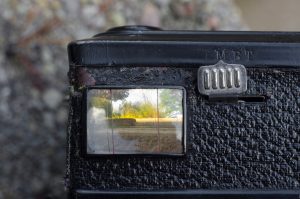
Like most box cameras, the Doppel Box has two viewfinders, one on top of the camera for images in portrait orientation, and one on the side for landscape photos. Unlike other box cameras however, the viewfinders have two lines in a location to indicate a 6×4.5 image. These lines appear in both viewfinders and make your framing of a 6×4.5 image very easy to do.
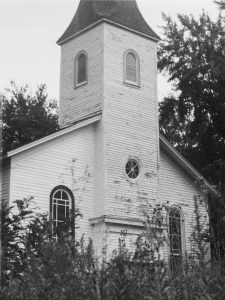
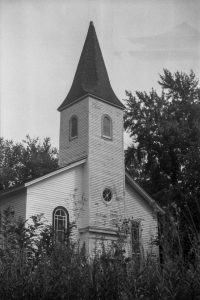 It’s worth mentioning that shooting a smaller image duplicates the effect of a modern crop sensor digital camera when using a full frame lens, in that the focal length of the lens turns into more of a telephoto length. The 10.5cm Certomat lens effectively becomes a 21cm telephoto lens in 6×4.5 mode. During my first roll through the Doppel Box, I shot two photos of the same subject, one in 6×9 and one in 6×4.5 to help illustrate this point. Look at the two images to the right. I shot both images of the same thing, standing in the same spot. The only difference is one was shot at 6×9 and the other at 6×4.5. You’ll also notice that despite 6×4.5 using half of a 6×9 frame, the aspect ratio is slightly different. The 6×9 image has a 1.5:1 ratio, whereas 6×4.5 has a wider 1.33:1 ratio, resulting in a slightly squarer image.
It’s worth mentioning that shooting a smaller image duplicates the effect of a modern crop sensor digital camera when using a full frame lens, in that the focal length of the lens turns into more of a telephoto length. The 10.5cm Certomat lens effectively becomes a 21cm telephoto lens in 6×4.5 mode. During my first roll through the Doppel Box, I shot two photos of the same subject, one in 6×9 and one in 6×4.5 to help illustrate this point. Look at the two images to the right. I shot both images of the same thing, standing in the same spot. The only difference is one was shot at 6×9 and the other at 6×4.5. You’ll also notice that despite 6×4.5 using half of a 6×9 frame, the aspect ratio is slightly different. The 6×9 image has a 1.5:1 ratio, whereas 6×4.5 has a wider 1.33:1 ratio, resulting in a slightly squarer image.
When shooting with the Doppel Box, there are three different locations for the aperture, shutter speed, and focus settings.
- The dual focus ranges are selected via a sliding switch on top of the camera, next to the portrait viewfinder. Your options are 2m – 5m and 5m – Infinity.
- Shutter speed settings are selected via a switch on the side of the camera, next to the landscape viewfinder. Your options are M (for Moment or Instant), B for Bulb, and T for Timed. On my camera, when the camera is in Timed mode, pressing the shutter release once opens the shutter, but pressing it again will not close it. I had to unselect Timed mode to get the shutter to close. I am not sure if this is normal behavior, or if mine is defective. I also never tried the camera with a shutter release cable as I had no need to actually try a Timed shot.
-
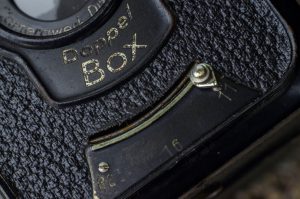
The aperture of the camera is changed by this slider, below the taking lens. Aperture sizes are selected via a curved slider on the front of the camera, beneath the taking lens. Your options are f/11, f/16, and f/22. The Doppel Box does not have an iris, but rather a metal plate with three different holes, one for each aperture size. This is important as you cannot select an in between setting to achieve something like f/14 or f/18. You must select whole sizes.
The camera has tripod sockets on the bottom and side of the camera for securing to a tripod, but they are the larger 3/8″ size instead of the more common 1/4″ size found on most cameras. If you want to use this camera with a modern tripod, you’ll need to use an adapter.
That’s pretty much it to using the Doppel Box. For a box camera, that’s quite a bit actually. This is the most feature rich box camera I’ve ever seen, and considering box cameras like these quickly fell out of favor after World War II, it’s likely there weren’t many made with a better feature set.
In use, I found the size and heft of the all metal body to be reassuring. While I always take care not to manhandle any camera, I always feel a bit of paranoia each time I pick up one of my cardboard Brownies. They’re so fragile, that I worry that the slightest slip of the hand could irreparably damage the camera. Not so with the Doppel Box. It may not double for a self defense weapon like a Kodak Medalist might, but it’s still a very robust camera that allows you to focus on photography rather than delicate handling.
I really enjoyed the viewfinders on the camera. Certo did a great job designing the indicator marks in both viewfinders for 6×9 and 6×4.5 shots. Since I did both on the same roll, I got to experience it both ways. Shooting with this camera in 6×4.5 mode was a bit difficult though since the approximate 21cm focal length means you have to stand very far away from large objects if you want them to be in frame. It is clear the Doppel Box was designed as a 6×9 camera first, and the 6×4.5 size is merely an add-on.
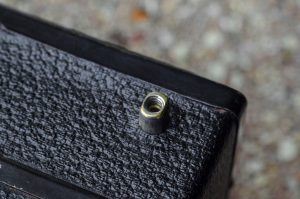
One minor annoyance I noticed with my copy was that the shutter release required quite a bit of pressure to release the shutter. The button itself sticks out of the side of the camera, but in order to fire the shutter, you have to press the shutter release to the point where it is flush with the side of the body and then keep pressing, almost to the point where you’re putting pressure on the side of the camera in order to get the shutter fire. This could very well be a symptom of age, and not characteristic of how the camera was designed, but since this is the only one I’ve ever come across, I cannot be sure. Thankfully, the shutter release is threaded for a shutter release, and while I didn’t employ one during my first roll, I imagine that using a shutter release cable would alleviate this issue.
All things considered, the experience of shooting the Doppel Box was excellent. This is without a doubt the highest spec and best built box camera in my collection and I was very happy to use it. Knowing a little bit about it’s history was icing on the cake, but how did the images turn out? The doublet lens should have certainly allowed for some pretty good shots, right?
My Results
My first roll of film through the Doppel Box was Arista EDU Ultra 100. I bought a couple of rolls of it on Amazon on a whim to try it out since it was very economically priced. As of the writing of this review however, it seems to have disappeared from Amazon’s site. I went into my purchase history to click on the order in which I bought the film and the link takes me to Arista sheet film, and not the 120 rolls. Perhaps it was discontinued or on permanent back order.
I read one website which suggests this film is rebadged Fomapan 100 but then there are others that suggest Arista EDU film is sourced from a variety of different emulsions. So, I really can’t be sure who made this particular film. Using it in an otherwise untested camera is a bit of a risk as it could be difficult to determine if any faults in my images were caused by the camera or the film.
I made it a point to shoot my first roll using both 6×9 and 6×4.5 on the same roll. Although the camera isn’t specifically setup to do this, I found that by consistently using the smaller 6×4.5 red window instead of the larger 6×9 red window for all of my shots and doubling up the numbers each time I shot a 6×9 image worked fine. Upon reviewing the film after it was developed, I did not overlap any frames or waste any space.

In total, I only took two 6×9 images as I wanted the economy of the half frame format. Earlier in this review, I show the same image of the church in 6×9 and not only can you see the wider image, but if you click on the image to see the full size image in your browser, you’ll see the 6×9 image benefits from the extra size showing a sharper and more clearly defined image. In the gallery above, the only other 6×9 image is the last one, of the barn.
I didn’t quite know what to expect from these images, but with the excellent build quality of the all metal camera, plus the doublet lens, I expected some really nice images, but sadly, it seems that all of the 6×4.5 images were a tad soft. If you look at every image in the gallery above (except the barn), when viewed full size they are all soft throughout the entire frame, even the center. This softness would have most likely been acceptable to someone in the 1930s making 6×4.5 contact prints, but in the 21st century when we can see all the detail, I found the images to be a bit lacking.
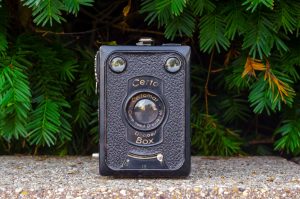
When shooting 6×9 however, the images greatly benefit from the additional space on the negative as I found the two that I shot to be pleasantly sharp. It certainly makes sense that a smaller negative is going to be less sharp than a larger one, but I didn’t expect to see such a noticeable difference. It would seem that with the difficulty of composing an almost telephoto image on a box camera combined with the softer images of the smaller frame, shooting 6×4.5 images in the Doppel Box brings with it significant compromises. For my next roll of film in the Doppel Box, I think I’ll limit it to 6×9 for the entire roll. Knowing that the doublet lens renders really nice full frame images, it will be interesting to see what I could do with a color roll of film.
The Certo Doppel Box may not be on the wish list of many collectors and it certainly will never generate the same levels of excitement as a Rolleiflex or Leica might, but I am extremely happy that this camera came to me. Not only for the story, but it’s just a really cool camera. Box cameras were almost always after thoughts, basic devices meant for the absolute beginner, but not so with the Doppel Box. It is built incredibly well and its list of features rivals that of many entry level cameras.
My Final WordHow these ratings work |
The Certo Doppel Box is a solid, all metal box camera made by a company who was no stranger to innovation. This model is chock full of premium features such as dual format, a doublet lens, two focus ranges, a threaded shutter release, and both T and B shutter speeds. The camera has a unique design, with handsome knobs, and excellent viewfinders. While I didn’t get the sharpest images at 6×4.5, the camera produced some very nice images at it’s native 6×9 size. This is a box camera unlike other box cameras and was not only fun to shoot, it also looks great on a shelf. While Doppel Boxes don’t show up with regularity, they make for an excellent addition to any collection. Highly recommended! | ||||||
| Images | Handling | Features | Viewfinder | Feel & Beauty | History | Age | |
| 0 | 1 | 2 | 2 | 2 | 0 | 40% | |
| Bonus | +1 for the complete package, a very innovative camera with features unlike others in it’s class | ||||||
| Final Score | 10.8 | ||||||
Additional Resources
http://www.collection-appareils.fr/x/html/camera-10575-Certo_Doppel%20Box.html
http://www.emtus.ch/certo-doppel-box.html
http://www.starefotoaparaty.cz/znacka/certo/certo-doppel-box

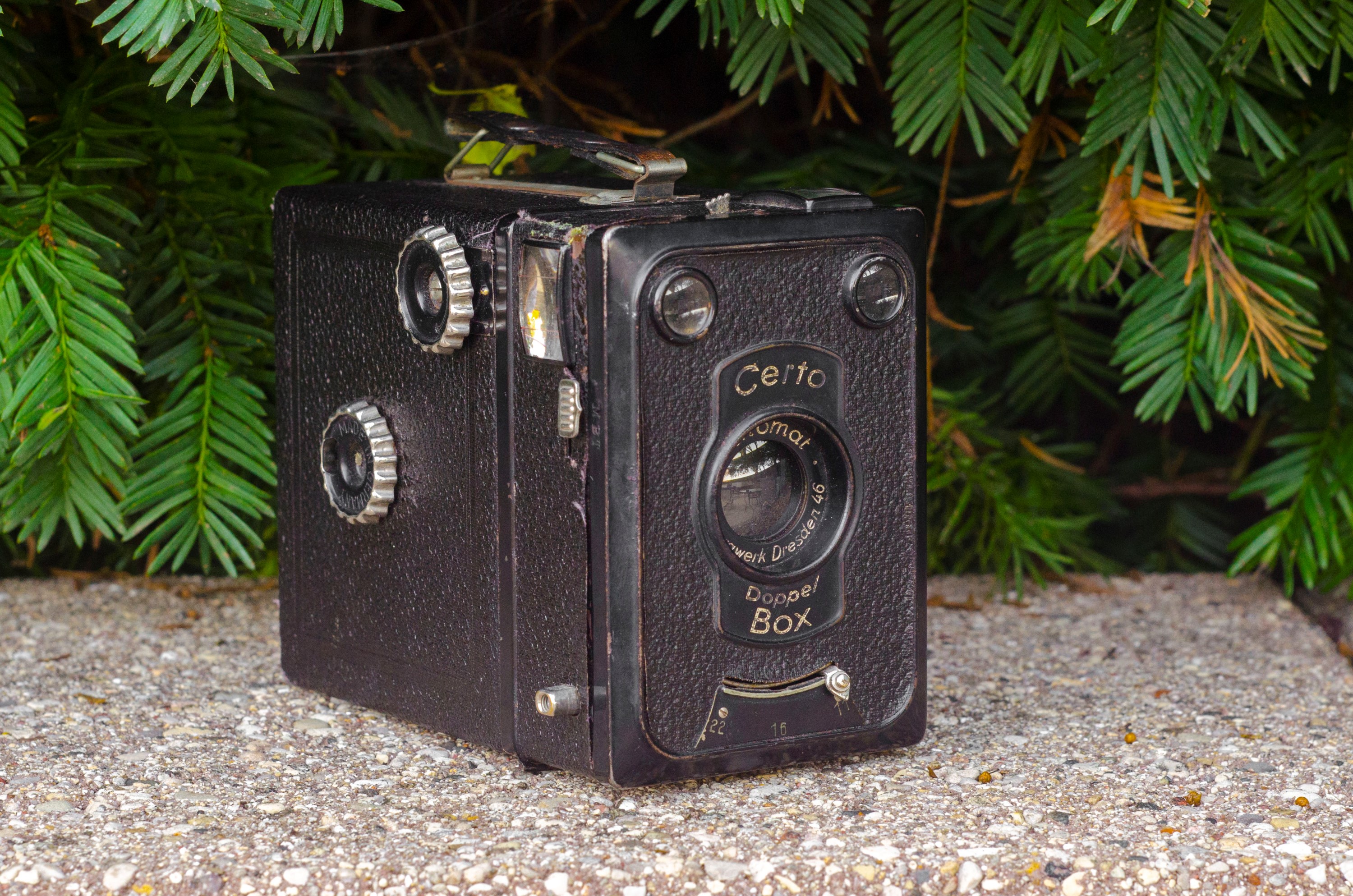
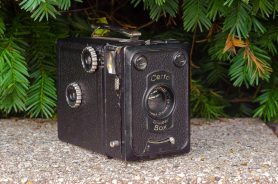
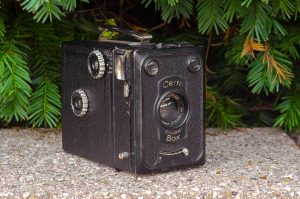









I love the story it comes with this interesting camera. Thanks for sharing this with us. As for Arista EDU Ultra 100 , you may get it at other places. They still make it. I use it and buy it from Bhphotovideo.com. They also have it at freestylephoto.biz . Mine says on the box Made in Czech Republic. There is only one factory it makes films over there and it is Foma. ( as far as I know) .
And thank you for all the other reviews of other cameras. I really enjoy it.
Michal
FWIW, Arista .EDU 100 is almost certainly repackaged Fomapan 100, which is sometimes available at Amazon.
I think that the original owner of this camera, Istvan Laszlo Magyar, escaped from the Soviets, not from the Germans. You don’t flee to Switzerland from Germans when you’re in Hungary 1945. Across what’s left of the Third Reich….
Anyway, I’m just waiting for my Certo Box.
Kismet, you are probably correct! I remember thinking the same thing, but that story was told to me by Istvan’s daughter, so I just left it as is. What we can be certain about though, is that I am sure you will love your Certo Box when it arrives! 🙂
I’m actually waiting for one Certo Box, one Agfa Box, and Two, as yet, unidentified box cameras…
Mike, could it be that the 4.5x6cm images are a bit softer because its mask alters slightly the position of the film plane ?
btw Put a link up to this great review on the Camera-wiki :
http://camera-wiki.org/wiki/Certo_Doppel_Box
That is very possible. The mask sits on top of the film, plane and would have the effect of moving the film back the thickness of the mask, thus throwing off the focus ever so slightly. I think that this being a box camera and the typical use of a camera like this was to make contact prints, no one cared about such minor focus errors back in the day.
Thanks for adding a link to the camera-wiki site. I’ve often wondered how to go about adding my links there. I don’t want to spam them, but have found many links on that site to be outdated or expired.
I was fascinated to read this review. The only other box camera that I know of that allows dual formats is an Ansco Shur Shot variant I came across on Ebay some time back. However, on that you had to adjust the film holder when loading (no mid-roll changes) and it was otherwise very basic. The only other cameras that I know of that allowed mid-roll format changes were the Konica Auto-Reflex and Auto-Reflex P which offered full and half frame on 35mm. I will be putting the Doppel Box on my wishlist.